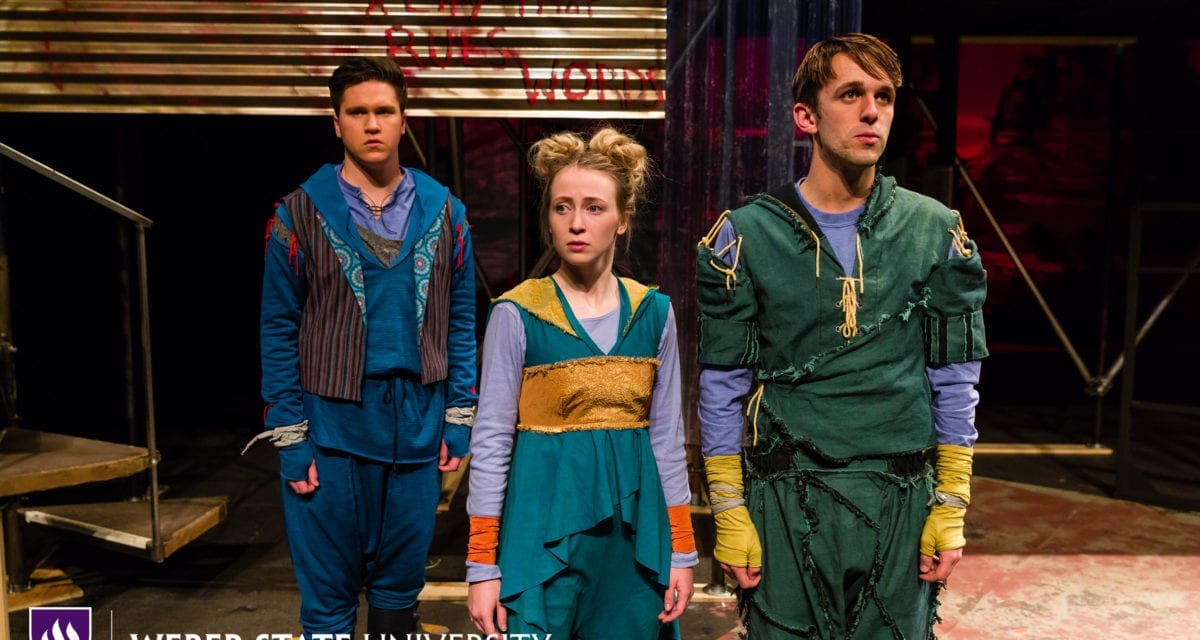
Show closes November 18, 2017
OGDEN — Weber State University‘s Department of Performing Arts made the bold decision to have “A Season of New Works”—an entire season of new material. Though I love seeing a classic show again as much as I love the comfort of an old, perfectly worn sweater, it’s exciting as a reviewer to have the opportunity to be part of something fresh and unique. Currently, WSU is producing Finegan Kruckemeyer’s Where Words Once Were, an approximately ninety-minute one-act exploring the power of language. Frankly, this show is one that has to be seen to be really understood or appreciated, but I will attempt to offer my insights without giving the plot away.
In the program’s Writer’s Note, Kruckemeyer explains that he was commissioned by the Kennedy Center to “write a play in which language was the main character. This provocation was so evocative, so shapeless, so poetic that many ideas came to mind. But eventually one was sat down with—that of a world allowing finite words, a boy possessing few, a girl afforded none.” In this post-apocalyptic world, language is seen as a threat and a potential weapon—as what sparked war, hatred, and chaos. As such, it is decided that language must be restricted and unified; everyone must speak the same tongue and there are only 1,000 permitted words to speak, write, or even think. When a new word is needed, an old word is omitted, always keeping the language to the 1,000 word limit.
I wondered about this number of words and how restraining it would really be, so I did a little research. According to the Economist blog, by age four, the average English-speaking child uses 5,000 words. By age eight, a child uses 10,000 words. The average adult regularly uses 20,000–35,000 words. In total, the Oxford English Dictionary has 171,476 current words (and that’s not counting the 47,156 obsolete words and 9,5000 derivative words.) With that perspective—that even a neurotypical four-year-old speaks with a vocabulary of 5,000 words—a limit of 1,000 words becomes all the more stark and restrictive.
Because this piece is written mostly using this 1,000 word restriction, precision and exactness to the script are essential, and the actors under Tracy Callahan‘s direction excelled. I am impressed by the clarity and meaning Callahan allowed the piece to have. It puzzles me to think what the script of Where Words Once Were must look like, as the show is a combination of traditional theater, modern dance movement, and essential audiovisual elements. Yet wherever Kruckemeyer’s instructions end and Callahan’s creative direction begins, Callahan effectively staged this sometimes abstract piece in a way that communicates the message without becoming muddled.

The cast of Weber State University’s Where Words Once Were. Copyright Weber State University 2017.
The cast is small at only eleven actors, but every actor contributed to the world’s ambiance. Each actor, even those without solo lines, constantly told a story through their acting, facial expressions, and movement, which made the show fun to watch. A great example of this was during the classroom scenes that take place in the upstairs of the futuristic, metal and scrap styled set designed by Sam Transleau. Though only three actors in the scenes actually have lines, all of the students are expressive and fun to watch. With movement choreographed by movement director Angenette Spalink, the students interact, react, and move in ways that reminded me of a Charlie Brown classroom in which each student has his or her own little drama going on. Scenes like these helped make the characters relatable, because despite the word limits and resulting awkwardness, the movement and acting showed the audience that these kids were still just kids, dystopian society or not.
The acting in this show is impeccable. Callahan Crnich plays Orhan, a boy who has grown up in this fractured society. Crnich brings youthfulness, intensity, and energy to the character of Orhan, and his charisma makes Orhan instantly likeable, which is particularly important since much of his communication has to be done through facial expressions. Orhan’s best friends, Kieran (played by Riley French) and Eila (played by Landry Thomas) are great sources of comic relief. Between French’s million-dollar smile and playfulness and Thomas’ spunk, these two supporting actors are delightful to watch. Kaitlyn Hipwell‘s Alli, Orhan’s mother, is lovable, warm, and creates meaning in lines beyond their word limitations.
Most notably in the cast is the Girl, played by Nick Rice. Rice’s character is critical to the play and if she faltered, the whole production would fail. Happily, Rice is engaging, honest, and as the narrator, holds the audience’s attention and interest throughout the show. I love the contrast that Rice gives the Girl from being narrator to engaging as part of the scenes. Rice’s Girl transformed from vivacious, outgoing, and friendly to invisible, reserved, and unassuming, important and difficult transitions in character that help emphasize the play’s message.
The costume design by Catherine Zublin beautifully compliments the set. Costumes are in line with the dystopian world and give the impression that the clothing is constructed for practicality and function, not fashion, and that whoever made the clothing simply had to make do. Notably, the Girl’s costume with her clear, plastic raincoat gave the character a necessary apartness.
Technically this show excelled, which is important to note as key projections, lights, and sounds have to happen precisely for the play to function. William Peterson‘s lighting design was effective and unobtrusive. Sound designer Jessica Greenberg complemented the sometimes eerie music of composer Carey Campbell. And without projection designers Tiffany Campbell and Daniel Garner, the show wouldn’t have had its same power or message.
I truly enjoyed this show and fully recommend it to anyone wanting a new and thrilling theatrical experience. WSU has done an exceptional job of taking this new work and bringing it to life with passion, intention, and meaning. I left this production touched and better for having seen it, and I hope as many people as possible get the opportunity to experience this same transformation.




